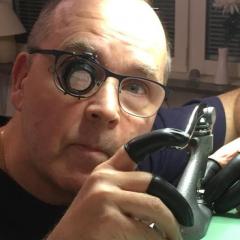Difficulties getting parts treated with Moebius 9504 clean
-
Recently Browsing
- No registered users viewing this page.
-
Topics
-
Posts
-
Hi All. I would appreciate some advice for a complete newbie on getting into watch servicing - nothing serious, just as a fun project. I've got a thing for hand-wound watches and would like to bring an old watch (or two) back to life, so looking to learn to do a strip-clean-oil-assemble cycle. I've toyed with this idea in the past (years ago) and picked up a couple candidates to learn on, but never found the time for them. One is an old Ingersoll, swiss-made 17 jewels. It seems to wind and tick. Casing, dial, glass are in great shape, so looks like a good candidate to me for the first service. The other is a Benrus DR23. It winds and makes a few reluctant ticks, but then seems to stop. Casing looks like a complete gonner, and the dial is in pretty poor shape too. If the movement is not broken and just needs a service, I wonder if there's any possibility of getting a cheapo Chinese casing & dial to fit this movement in, or is it extremely unlikely to be the right size? For a start, I want to strip & assemble a movement, perhaps a dozen times to build up the basic parts handling skills. I see that online advice is to buy a Chinese-made ST36 for this purpose. Can I just go at the Benrus or Ingersoll instead, or does it make more sense to get a cheap ST for this? Thank you.
-
Hi, I have this vintage Navitimer 806 with a bezel that plays a little bit as shown in this video: https://imgur.com/a/2NjdiF0 How would you fix this? I don't see where a gasket would fit for instance. Also, it seems this issue happens sometimes with older Navitimers. Thanks
-
This is a screenshot of a video of it running. Not the best quality, though.
-
By Neverenoughwatches · Posted
Depends what sizes of watches you mostly service . If you were to say pocket watches then you might benefit by wholly replacing the 9010 for 9020. As a rough guide hp500 is twice the viscosity of 9020 which is twice the viscosity of 9010 at 20°c. So hp500 would give you a more mid-range oil between thin 9010 and HP1300, but as it happens hp750 is more mid- range than hp500, but is that more or less useful when oiling a train of wheels. After the barrel arbor the jump down in pivot size is around half, then after the centre wheel maybe more than half until the escapement. And pivot size isn't especially a deciding factor, as the torque and speed of a pivot would be more relevant when thinking about which oil to choose. So 750 might only be useful on a centre wheel and nothing else, and 500 might be better than 1300 for oiling the centre wheel but still comprises the rest of the train, where 9020 would be ok for the train but too thin for the centre wheel, leaving only 1300 for the oiling of it. You see the problem we're having here. What can be ok for one thing is less ok for another in a different way, damping down power compared to oil spread. Maybe mixing a drop from two opposite range viscosity synthetic oils will give you some approximate thickness of an in-between . You want a short answer now ? I tnink I'd go with the 9020. Now be prepared for a whole host of different answers. Then to go with this, watch manufacturers change their minds about which oils to use more times than actresses change their knickers.
-





Recommended Posts
Join the conversation
You can post now and register later. If you have an account, sign in now to post with your account.
Note: Your post will require moderator approval before it will be visible.